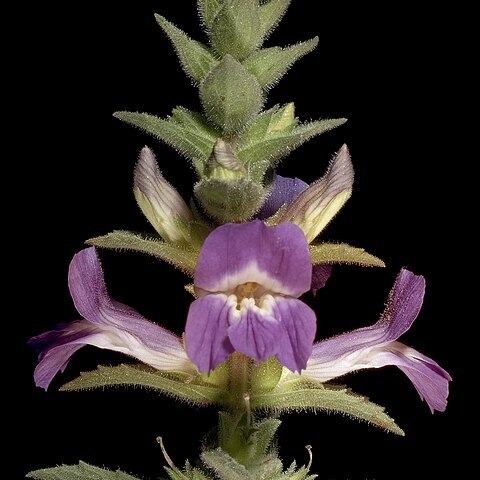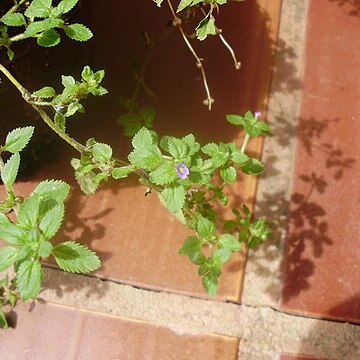Erect or sprawling herbs, the stems mostly pubescent, drying angled, branch-ing freely. Leaves opposite or ternate, ovate or elliptical, mostly serrate, pubes-cent, often glandular punctate, petiolate, or subsessile. Inflorescences 1-3 flowers in the leaf axil, often geminate or ternate, the peduncles slender, ebracteate. Flowers with the calyx 5-lobed to near the base, the lobes narrow, sometimes slightly unequal; corolla white, blue, or purplish, often drying dull orange, tubular to narrowly campanulate, 2-lipped, the upper lip entire, emarginate or 2-lobed, bearded in the throat, the lower lip 3-lobed, the tube often pubescent inside; stamens 4, the filaments mostly inserted in pairs at somewhat different levels, glabrous, 1 pair of anthers sometimes with thecae differing from the others, the thecae held apart by an enlarged globose or armlike connective, parallel or divaricate, sometimes pubescent, a staminode sometimes present; ovary smooth, conical, mostly compressed, the style terete, glabrous, the stigma ligulate, often with 2 minute but distinct lateral appendages; placentas drying to form a narrow peg which does not run to the top of the ovary, the septum, in the apical portion at least, remaining with the capsule walls, in the lower portion sometimes remain-ing with the placenta; dehiscing loculicidally and septicidally '/2 way or all the way down; seeds small, numerous, oblong pyriform, often longitudinally 6-10 sulcate, the surface minutely rugose.
More
Capsule globose, ovoid, sometimes acuminate, valves 2, bifid or 4; usually loculicidally dehiscent Seeds numerous, small, striate.
Leaves opposite or verticillate, occasionally alternate below, simple, subentire to variously toothed.
Corolla tubular; tube cylindric; upper lip broad, emarginate to entire; lower lip trilobed.
Stamens 4, didynamous, included; filaments slender; anther thecae stipitate, all fertile.
Annual, glandular-pubescent, often aromatic herbs, much-branched, or subshrubs.
Flowers zygomorphic in lax terminal racemes or solitary-axillary, pedicellate.
Calyx 5-lobed; lobes narrow, equal or subequal.
Pedicels uni-or bibracteolate.


